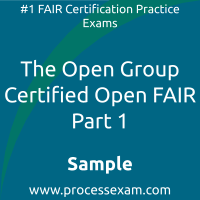 You have to pass the OG0-041 exam to receive the certification from Open Group. To increase the effectiveness of your study and make you familiar with the actual exam pattern, we have prepared this Open Group Open FAIR Part 1 sample questions. Our Sample The Open Group Open FAIR Part 1 Practice Exam will give you more insight about both the type and the difficulty level of the questions on the Open Group Open FAIR Part 1 exam.
You have to pass the OG0-041 exam to receive the certification from Open Group. To increase the effectiveness of your study and make you familiar with the actual exam pattern, we have prepared this Open Group Open FAIR Part 1 sample questions. Our Sample The Open Group Open FAIR Part 1 Practice Exam will give you more insight about both the type and the difficulty level of the questions on the Open Group Open FAIR Part 1 exam.
However, we are strongly recommending practice with our Premium The Open Group Certified Open FAIR Part 1 Practice Exam to achieve the best score in your actual Open Group OG0-041 Exam. The premium practice exam questions are more comprehensive, exam oriented, scenario-based and exact match of The Open Group Open FAIR Part 1 exam questions.
Open Group Open FAIR Part 1 Sample Questions:
01. Why is it important to consider diminishing returns in FAIR analysis?
a) It avoids regulatory penalties
b) It helps optimize effort and analysis resources
c) It ensures fixed numeric accuracy
d) It prevents stakeholder questions
02. The term __________ is used in FAIR to describe outcomes that could happen, regardless of their likelihood.
a) Vulnerability
b) Probability
c) Possibility
d) Risk
03. What is the key difference between subjective and objective data in the context of FAIR measurement?
a) Subjective data is based on opinion; objective data is based on empirical evidence
b) Objective data must be visualized; subjective data cannot
c) Objective data is untrustworthy in high risk scenarios
d) Subjective data always produces more accurate results
04. When used alongside frameworks like NIST CSF, FAIR adds __________ capability to enhance their outputs.
a) qualitative storytelling
b) regulatory enforcement
c) quantitative analysis
d) operational checklists
05. Which component is most essential when building a business case from FAIR-based results?
a) Color-coded risk matrices
b) Threat agent names
c) Stakeholder mapping
d) Loss magnitude and frequency metrics
06. Using __________ data like logs and system reports provides empirical support in FAIR analysis.
a) Subjective
b) Intuitive
c) Objective
d) Inferred
07. Which Open FAIR component directly quantifies the number of times a threat is expected to act against an asset per year?
a) Threat Event Frequency
b) Vulnerability
c) Loss Event Frequency
d) Primary Loss Magnitude
08. Why are Open FAIR analyses not reliable predictors of the future?
a) They use only qualitative techniques
b) They are built on probabilistic estimations, not deterministic guarantees
c) They rely on intuitive guesswork
d) They use outdated risk models
09. How does FAIR encourage handling uncertainty in inputs?
a) By ignoring it to keep results simple
b) By using broad, unbounded ranges
c) By always assigning fixed values to variables
d) By using probabilistic ranges and distributions
10. What does FAIR encourage when presenting results that include uncertainty?
a) Hide the uncertainty to reduce confusion
b) Present a single deterministic number
c) Show ranges and confidence levels
d) Round all values to the nearest whole number
Answers:
Question: 01
Answer: b |
Question: 02
Answer: c |
Question: 03
Answer: a |
Question: 04
Answer: c |
Question: 05
Answer: d |
Question: 06
Answer: c |
Question: 07
Answer: a |
Question: 08
Answer: b |
Question: 09
Answer: d |
Question: 10
Answer: c |
If you find any errors or typos in The Open Group Certified Open FAIR Part 1 (OG0-041) sample question-answers or online Open Group Open FAIR Part 1 practice exam, please report them to us on feedback@processexam.com
 You have to pass the OG0-041 exam to receive the certification from Open Group. To increase the effectiveness of your study and make you familiar with the actual exam pattern, we have prepared this Open Group Open FAIR Part 1 sample questions. Our Sample The Open Group Open FAIR Part 1 Practice Exam will give you more insight about both the type and the difficulty level of the questions on the Open Group Open FAIR Part 1 exam.
You have to pass the OG0-041 exam to receive the certification from Open Group. To increase the effectiveness of your study and make you familiar with the actual exam pattern, we have prepared this Open Group Open FAIR Part 1 sample questions. Our Sample The Open Group Open FAIR Part 1 Practice Exam will give you more insight about both the type and the difficulty level of the questions on the Open Group Open FAIR Part 1 exam.